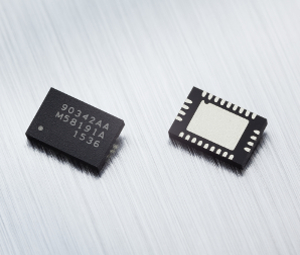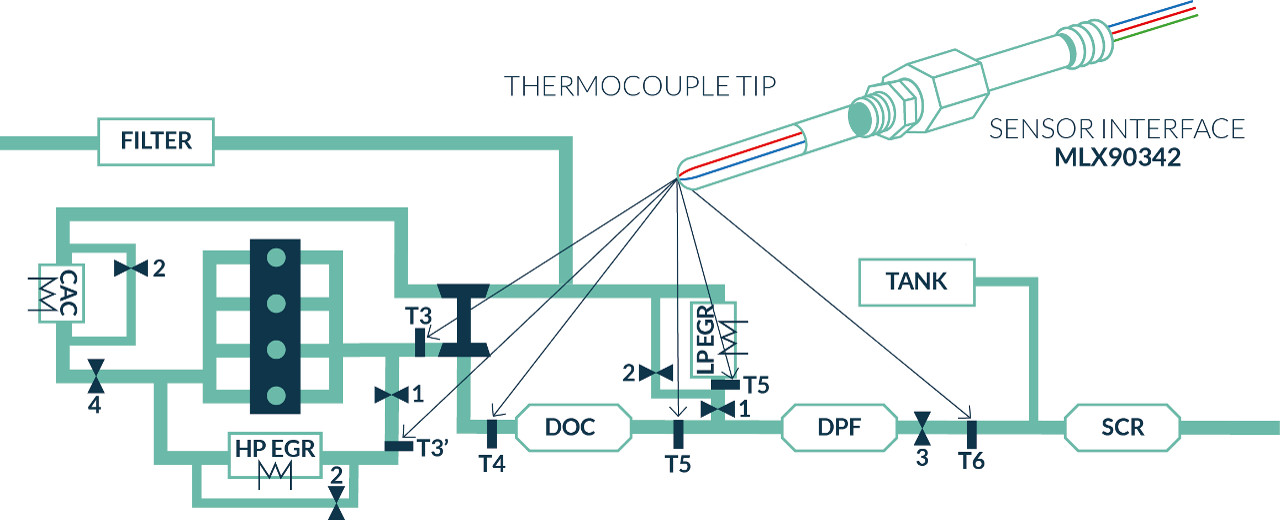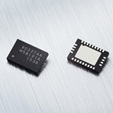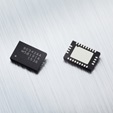Engine downsizing mandates next generation temperature sensor technology
By Luc Buydens, Melexis
The latest updates to the Corporate Average Fuel Economy (CAFE) directive are set to have far-reaching implications for the automotive industry. They mean that car manufacturers will need to make substantial improvements to fuel economy across their entire range of models – with 40mpg being dictated by 2017 and this being further ramped up to 49mpg in the 2022 timeframe. The long-term objective is for all cars shipped to exceed ambitious fuel economy figures of 54mpg by 2025. It is estimated that, over the course of the next decade, the execution of these CAFE directives will result in the saving of over 2 billion barrels of oil and consequently bring about a 1.1 billion ton reduction in CO2 emissions.

 There are several key places under the hood (generally downstream of the engine) where high temperatures need to be measured to a high degree of precision, so that the engine management system can ensure all systems are running at peak performance and lowest emission levels, while assuring that a small safety margin is maintained to avoid that the engine ‘melts’ if operating temperatures exceed material limits. Among these are the turbo charger, exhaust gas recirculation (EGR), particulate filters, selective catalytic regeneration (SCR) and diesel oxidation catalyst (DOC) mechanisms. With the smaller engine dimensions that CAFE directives are leading to, the temperatures being witnessed at each of these locations will be pushed upwards, and the temperature tolerances that need to be adhered to will get much tighter. The increased levels of exhaust gas treatment that these more compact engines will require (in order to check that filters are working properly and to make certain that filter regeneration is correctly carried out) are also a major impetus for improved temperature measurement accuracy.
There are several key places under the hood (generally downstream of the engine) where high temperatures need to be measured to a high degree of precision, so that the engine management system can ensure all systems are running at peak performance and lowest emission levels, while assuring that a small safety margin is maintained to avoid that the engine ‘melts’ if operating temperatures exceed material limits. Among these are the turbo charger, exhaust gas recirculation (EGR), particulate filters, selective catalytic regeneration (SCR) and diesel oxidation catalyst (DOC) mechanisms. With the smaller engine dimensions that CAFE directives are leading to, the temperatures being witnessed at each of these locations will be pushed upwards, and the temperature tolerances that need to be adhered to will get much tighter. The increased levels of exhaust gas treatment that these more compact engines will require (in order to check that filters are working properly and to make certain that filter regeneration is correctly carried out) are also a major impetus for improved temperature measurement accuracy.
Key attributes for automotive temperature measurements
There is an array of different attributes that temperature sensor subsystems need to be able to address if they are going to show full effectiveness in downsized automobile engines. The most important of these are as follows:
- Ability to deal with both the elevated temperatures involved and also the tighter temperature tolerances
- Better diagnostics capabilities to verify that the temperature data received by the electronics control unit (ECU) and engine management software can always be relied upon
- Support a lowering of the bill of material costs
- Provide a single input to the ECU for multiple sensors, rather than needed a separate input for each sensor (as there are only a limited number of ECU inputs and these are already in great demand)
- A convenient form of connectivity. Increasingly the SAE J2716 SENT protocol is being employed in various elements of automotive design, for transferring data from sensors back to the controlling electronics hardware
An overview of temperature sensing technologies
Various techniques can be used for ascertaining temperature. Measuring the value of a temperature dependent resistor has, until now, proved to be the best way to accomplish this in automobile engines, with car manufacturers integrating thermistors at various points under the hood. These would either be ceramic negative temperature coefficient (NTC) devices or alternatively they would be platinum-based positive temperature coefficient (PTC) devices. Most NTC thermistors are used for lower temperature ranges (below 600˚C). They also have only medium level accuracy (which as tolerance margins continue to tighten, is going to become more of an issue). PTC thermistors have slightly better accuracy (though this unfortunately comes with a higher unit cost, due to their platinum construction), but, for reliability reasons, they are limited to temperatures reaching 900˚C.
In industrial applications, optical technologies are deployed, with infrared sensors able to determine the surface temperature of a particular body in a contact-less manner. Though such a method can comfortably deal with the high temperatures that are going to be present in the new breed of efficient car engines (comfortably measuring to 1500°C), they are not suitable for use in this particular context. Automotive powertrain applications are characterized by large quantities of particulates, as well as the presence oil and grease, which would impair the performance of the sensor over time. All these factors make this approach to temperature measurement completely impractical.
 Thermocouples also offer an extensive temperature range (generally reaching up to 1300˚C) and are inherently more robust. These devices are already commonly used in industry and in automotive testing, with 30-40 sensors being placed at different points over the vehicle for temperature monitoring purposes. As a result, automotive engineers are very much familiar with this technology. The temperature that is measured will equate to the output voltage that is produced. The voltage signal is quite small though (just a few mV) and herein lies the problem. Despite being able to deliver good accuracy within a laboratory setting, when applied to an uncompromising automotive electronic environment, difficulties start to arise. The presence of voltage spikes, electro-magnetic interference and other sources of noise that are basically unavoidable within a working vehicle all have an effect on the signal integrity of thermocouples. This has been a sizeable obstacle preventing their implementation into engine designs. It is further compounded by the fact that thermocouple wiring is quite expensive. Finally there is the sensor drift aspect to consider. Thermocouples are stable in nature, but when there are such tight tolerances as the ones now involved, even small changes to their performance characteristics over time could become important (as these devices will be in-situ for periods of over a decade).
Thermocouples also offer an extensive temperature range (generally reaching up to 1300˚C) and are inherently more robust. These devices are already commonly used in industry and in automotive testing, with 30-40 sensors being placed at different points over the vehicle for temperature monitoring purposes. As a result, automotive engineers are very much familiar with this technology. The temperature that is measured will equate to the output voltage that is produced. The voltage signal is quite small though (just a few mV) and herein lies the problem. Despite being able to deliver good accuracy within a laboratory setting, when applied to an uncompromising automotive electronic environment, difficulties start to arise. The presence of voltage spikes, electro-magnetic interference and other sources of noise that are basically unavoidable within a working vehicle all have an effect on the signal integrity of thermocouples. This has been a sizeable obstacle preventing their implementation into engine designs. It is further compounded by the fact that thermocouple wiring is quite expensive. Finally there is the sensor drift aspect to consider. Thermocouples are stable in nature, but when there are such tight tolerances as the ones now involved, even small changes to their performance characteristics over time could become important (as these devices will be in-situ for periods of over a decade).
Having recognized that the downsizing trend would call for a new approach to engine temperature measurement, a specialist team at Melexis were assigned the project of developing the sensor interface technology needed to make thermocouples more suitable for under the hood deployment. This would call for use of cutting-edge signal conditioning techniques.
The principal challenges faced were enabling the high precision measurement of the small thermocouple voltages, and assuring the long-term stability of this measurement. It was also agreed that more sophisticated diagnostics capabilities would be needed, to ensure that the temperature figures given to the ECU would be trustworthy. Quite often existing diagnostic mechanisms will only check that the temperature sensors are operating correctly at the car’s ignition phase. This does not take into account that, over the course of an extended journey, a fault could arise, which is thus not then promptly responded to. The vehicle could thereby give off excess emissions and serious damage could potentially be done to the engine in the process. Hence, what is needed is continuous diagnostics. Also, to simplify matters, such functionality should be taken care of without needing involvement of the ECU.
The result of this development project was the MLX90342 quad-channel thermocouple interface IC. Supporting a measurement temperature range that goes all the way up to 1300°C, this device allows up to 4 connected thermocouples to deliver ±5°C (typical) accuracy at 1100°C - thereby improving accuracy levels compared to devices currently on the market by a factor of 2. It is capable of transferring temperature data via its digital interface (which conforms to Revision 3 of the SENT protocol) and has a 50Hz refresh rate for every thermocouple. These ICs have been designed to exhibit the strongest possible linearity over a wide temperature range, thanks to on-board cold junction compensation and advanced linearization features. Furthermore, they support calibration procedures that maximize initial accuracy. Industry standard thermocouples have specific characteristics and, during vehicle production, the engineers from the car manufacturer’s chosen tier 1 partner will be able to program into these ICs how the connected thermocouples differ from the pre-defined ideal characteristics.
Legislative measures mean that the downsizing of car engines is inevitable. The technology needed to support the continued operations of these engines is now starting to emerge. Through the progression being made in relation to sensor interfaces - with IC devices that deliver superior performance and a greater scope of built-in functionality – the challenges that CAFE directives represent will be overcome.



